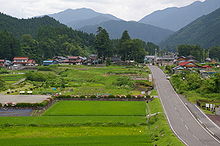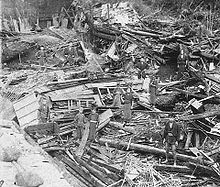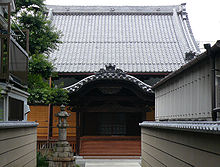- 1891 Mino-Owari earthquake
-
1891 Mino-Owari earthquake Date October 28, 1891 Magnitude 8.0 Ms Epicenter 35°36′N 136°18′E / 35.6°N 136.3°ECoordinates: 35°36′N 136°18′E / 35.6°N 136.3°E Countries or regions Japan, Mino Owari Casualties 7,273 estimated dead, 17,175 casualties The Mino-Owari Earthquake (美濃尾張地震 Mino-Owari Jishin) was a large earthquake that struck the former provinces of Mino and Owari in the Nōbi Plain area during the Meiji period in Japan. It is also referred to as the Nōbi Earthquake (濃尾地震 Nōbi Jishin) or the Great Nōbi Earthquake (濃尾大地震 Nōbi Daijishin). It is the largest known inland earthquake in Japan.
Contents
History
The earthquake struck on October 28, 1891, at 6:38am. Based on the scale of destruction, it has since been estimated to have had a magnitude of 8.0 on the Richter Scale.[1] Its epicenter is believed to have been the Neodani Fault (35°35’N, 136°20’E), which is located in the present day city of Motosu, Gifu Prefecture. It is believed to be the largest earthquake that has ever occurred whose epicenter is beneath Japanese soil.[1] It is also one of the largest earthquakes in the world's history. When the fault line broke, the height difference between the two sides was approximately six meters.
Damage
Aichi and Gifu prefectures suffered extensive damage. Damage also occurred in the neighboring Shiga and Fukui prefectures. According to records, there were approximately 7,273 deaths and 17,175 casualties, as well as complete destruction of over 140,000 homes. On mountains near the quake's epicenter, all of the trees were knocked down, leaving what is called a "bald mountain." In the city of Gifu and the surrounding areas, fires broke out, causing even more damage. The first newspaper reports described this complete destruction of Gifu by saying that "Gifu has disappeared." Many important structures in Gifu, including Kanō Tenman-gū and Zenkō-ji, were greatly damaged in the resulting fires.
Though the walls of Nagoya Castle and surrounding lodgings from the Edo period were not damaged, modern buildings that were built with Western architectural knowledge subsequently collapsed. The Nagaragawa Iron Bridge and other structures, including brick structures, etc., that were not earthquake-resistant were destroyed. It is because of this earthquake that interest in creating earthquake resistant structures greatly increased.[2]
Book memorialising the earthquake
In 1893, seismologist John Milne and engineer W.K. Burton worked together in co writing and co photographing a book that was published in Yokohama, and recorded the disastrous great Nōbi Earthquake of 1891. The book captured the plight of the Japanese people and the impact of an earthquake on their environment, in dramatic images that were printed by Ogawa Kazumasa.[3][4]
Earthquake preparation and remembrance
Gifu's Earthquake Memorial Hall dedicated to the victims of the Mino-Owari Earthquake
In Gifu Prefecture, October 28 has been declared "Prefectural Earthquake Disaster Prevention Day" to help residents prepare for earthquakes. Additionally, on the 28th of every month, there is a Buddhist memorial service for all of the earthquake's victims at the Earthquake Memorial Hall.[5]
Further reading
Gregory Clancey. Earthquake Nation: The Cultural Politics of Japanese Seismicity (Berkeley, Calif.: California University Press, 2006)
References
- ^ a b Mino Earthquake. (Japanese) Tokyo Science Museum. Accessed July 5, 2007.
- ^ Gregory Clancey. Earthquake Nation: The Cultural Politics of Japanese Seismicity (Berkeley, Calif.: California University Press, 2006)
- ^ Ogawa Kazumasa, Japanese Photographer [1]
- ^ The Great Earthquake in Japan 1891 Milne, John, Burton, W. K. & Ogawa, K Publisher: Lane, Crawford & Co., Yokohama 1893 , with 30 Plates [2]
- ^ Gifu City Walking Map. Gifu Lively City Public Corporation, 2007.
Categories:- History of Nagoya
- Aichi Prefecture
- Gifu Prefecture
- Earthquakes in Japan
- 1891 in Japan
- Empire of Japan
- 1891 natural disasters
- 1891 earthquakes
Wikimedia Foundation. 2010.




